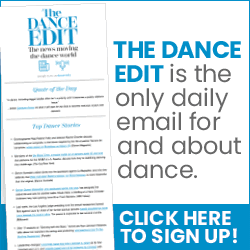State of NYC Dance and Workforce Demographics
Friday, October 21, 2016
State of NYC Dance and Workforce Demographics
Today, Dance/NYC releases State of NYC Dance and Workforce Demographics. With this new research, prepared by DataArts, we expand our work to reveal the activity and economics of dance organizations and dive more deeply into the demographics of their workforce than ever before. By incorporating a pilot demographics survey by DataArts, we act on our commitments to advancing an inclusive and equitable workforce and establishing key benchmarks to guide action and measure progress over time.
.jpg) Visit Dance.NYC for the full report.
Visit Dance.NYC for the full report.
On the surface, the state of dance in New York City may appear bright. Aggregate organizational data shows how the field emerged from the Great Recession financially stronger and is contributing to the fabric of the city in a real and vibrant way, with a sizable and growing employee base, thousands of performances and educational programs, millions in paying attendees, and $302 million in aggregate expenditures.
Yet there are worrying trends over the six-year period studied. Most notably, dance-making organizations report a 20% decrease in the number of paying attendees to their live performances, suggesting a need for new audience engagement strategies. Government funding declined 25% overall, with Federal support down 37% and City support down 31%, encouraging louder budget advocacy for discipline-specific funds. The number of jobs increased, but the newer jobs are significantly more part-time than full-time, raising questions about how, and for whom, dance can be a viable career path.
Further, segmented organizational analyses expose severe inequities in the distribution of resources. Growth in total revenue and expense is tied primarily to the few dance organizations with operating budgets of more than $5 million. Groups with annual budgets of less than $100,000; $100,000 to $499,999; and $1 million to $4.9 million all lost contributed and earned sources, and cut expenses. The smallest groups, which demonstrate the greatest capacity to adapt, were the hardest hit, losing 42% in support from their boards and trustees and 38% from foundations.
The findings show Manhattan-based groups, 67% of the population studied, attract 92% of total revenue, signaling need for investment outside the borough.
The workforce demographics survey adds critical dimension to understanding this landscape and the relationship between dance workers and the New York City population as a whole. The survey complements and extends recent studies by Ithaka S+R on the demographics of New York City’s Department of Cultural Affairs’ grantees, which show dance leading the major disciplines of theater, music, and museums in terms of female representation and racial diversity in its workforce.
The survey adds value by capturing data from an individual rather than an organizational level and by offering additional identity categories, including LGBT and disability, to help ensure individuals see themselves in the data. The category of disability was called for by Dance/NYC’s recent Discovering Disability: Data & NYC Dance.
There is some promising news for dance in the survey results. In terms of gender, 65% of respondents identifies as female, outpacing the city’s overall population, which is 52% female according to census data. The portion of respondents who identify as LGBT is substantial at 21%. While indicating opportunity to better engage people over 70, the findings on age generally align with the city’s population, which skews young.
However, survey findings point to entrenched patterns of exclusion of African, Latinx, Asian, Arab, and Native American (ALAANA) populations and disabled people by dance organizations. With 68% of respondents self-identifying as white non-Hispanic, the survey offers a snapshot of the workforce that is out of step with the racial and ethnic makeup of the city’s population, which is 44% white non-Hispanic. Consistent with Ithaka S+R findings, racial diversity appears to decrease the farther one looks up the ladder of seniority, from general staff to senior staff positions and boards.
In terms of disability, 5% of respondents identifies as disabled, only half the percentage (10%) of New Yorkers who identifies as disabled.
Above all, the survey findings invite constructive responses for policy, funding, and programs to increase racial diversity and the integration of disabled people along the continuum of career readiness and advancement—from enhanced classroom practices to paid internships and leadership training. When viewed in the context of organizational segments, they also signal opportunities for attention and investment in educational organizations and organizations with budgets of less than $100,000, whose workforces are least likely to identify as white non-Hispanic and most likely to identify as disabled.
Far more than a report on the status quo, State of NYC Dance and Workforce Demographics is a call to join in addressing inequities in dance and culture. The call is urgent, as the New York City Department of Cultural Affairs begins a comprehensive cultural planning process that will shape both local and national agendas.
Dance/NYC invites you to weigh in with your recommendations for how best to turn the data into action and ensure that dance becomes truly inclusive of all of New York City’s artists and communities. Please share your ideas at Dance.NYC.
As immediate next steps, Dance/NYC plans to convene the field to broker solutions and to pursue additional data sources, especially on fiscally sponsored artists, to ensure we are as expansive as possible in our approach. Please join the Dance/NYC Symposium on March 5, 2017, when participants will discuss findings. Visit Dance.NYC to register now.
About Dance/NYC
Dance/NYC’s mission is to promote and encourage the knowledge, appreciation, practice, and performance of dance in the metropolitan New York City area. It embeds core values of equity and inclusion into all aspects of its programs and operations. It works in alliance with Dance/USA, the national organization for professional dance.
This study was made possible with leadership support from The Andrew W. Mellon Foundation and the New York State Council on the Arts, with the support of Governor Andrew M. Cuomo and the New York State Legislature. Dance/NYC research is supported, in part, by the Stavros Niarchos Foundation and by the City of New York, Bill de Blasio, Mayor, and the New York City Council, Melissa Mark-Viverito, Speaker, through the Department of Cultural Affairs, Tom Finkelpearl, Commissioner.








